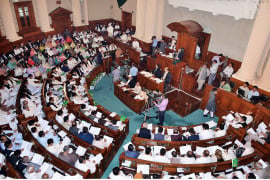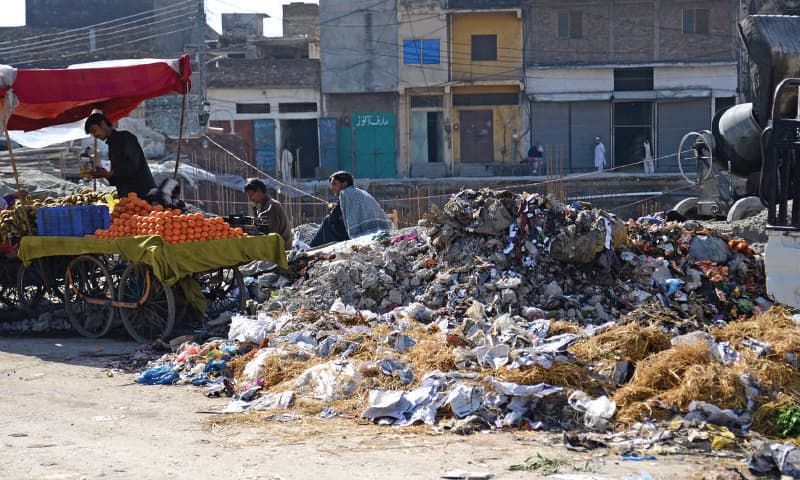
Until the time we have more detailed studies analysing the results of the elections of February 2008 and May 2013, we will have to do with some broad generalisations. Even those show some revealing trends which help us to understand the hard positions taken by the PTI and the PAT in the summer and fall of 2014. There was an increase of 7.8 million people who voted in 2013 compared to the number that casted votes in the 2008 election. This increase of almost 22 per cent was twice the increase in the number of registered voters. This shows up in the participation rates which increased by almost 9 per cent points. What were the choices exercised by this increase in the number of total vote?
It is interesting to note that the PTI captured almost the same number of votes as the increase in the total votes cast. While it is improbable that a 100 per cent of the new voters went to Imran Khan’s party which did not participate in the 2008 elections, it is fair to suggest that a significant number of the new entrants into the electorate were claimed by the PTI. The quarter million vote loss by the ANP that had poorly governed the province of Khyber-Pakhtunkhwa was mostly captured by the PTI. Two parties, the PPP and the PML-Q, also lost voters. The first was accused of poor governance by the citizenry, a charge that it did not really contest. It was in the same boat as the PPP. The PML-Q had outlived its utility; it was the creation of the military government headed by General Pervez Musharraf. The PML-N and the PTI moved into the space lost by these parties. The voter swing was reflected in the distribution of seats in the National Assembly. The PML-N increased its presence almost two and a half times by winning an additional 97 seats. The PPP lost 76 seats while the PTI gained 35 seats. The ANP was another major loser, dropping all but one of its seats.
The elections saw the emergence of a new political force. Led by Imran Khan, the PTI brought in the urban middle class into the political arena. This was a formidable force relatively new to politics. Among those who supported the cricket-turned-politician and the PTI were the urban youth, well versed in the ways of the modern world and not pleased with the way their country was being governed. They wanted change and believed that Imran and his party were in a position to bring it. They turned up in very large numbers to the rallies organised by the PTI in which Imran’s message of change resonated. They went to the polls in large numbers. When the results were in, the PTI won the second largest proportion of votes, almost 17 per cent of the total, slightly more than one half of the proportion that supported the PML-N. The PPP came in third, slightly behind Imran’s party. For a newcomer to do so well and with the assistance of a non-traditional voting group, was seen as the harbinger of change in a society bound by tradition. But Imran was not happy with the result and his impatience increased as the administration in Islamabad headed by the PML-N under the leadership of Nawaz Sharif seemed to stumble. It seemed, that he did not to have the leadership skills needed to deal with Pakistan’s difficult economic and social situation and to place the country in a fast changing global environment.
While Imran’s support came from the upper segments of the middle class, those at the bottom of this large population cluster were also looking for a place in the system. Most of this group of people was made up of the recent graduates into the ranks of the middle class. A significant number of these people had climbed out of poverty into the middle class status because of the remittances they had received from their relatives working abroad, mostly in the Middle East. These two segments of the population made their political choices foretold by Professor Albert Hirschman in his classic work, Exit, Voice and Loyalty. The PTI used “voice” as their weapon, loudly asking for the creation of space within the political system that remained dominated by traditional forces. The PAT chose “exit” as its preferred option, campaigning for a complete change in the existing political structure. It was not asking for accommodation as was Imran Khan and the PTI. Qadri and the PAT wanted to stage a “revolution” that would completely overturn the old system. The PAT’s influence and the mobilisation of tens of thousands of its people can be traced to the impact on society of the diasporas in the Middle East.
Imran Khan, on the other hand, appealed to the upper segment of the large middle class. The youth that came from the families with strong links in the diasporas in the West had borrowed the value systems from these Pakistani groups. Again without the benefit of surveys, simple observation suggests that there are not many households represented in this group that don’t have family members living and working outside the country.
Published in The Express Tribune, September 29th, 2014.
Like Opinion & Editorial on Facebook, follow @ETOpEd on Twitter to receive all updates on all our daily pieces.
COMMENTS (5)
Comments are moderated and generally will be posted if they are on-topic and not abusive.
For more information, please see our Comments FAQ


















1710998259-0/pti-(1)1710998259-0-270x192.webp)



















Its an awakening process that Imran Khan has started........and it was long overdue. The process will be slow because the entrenched corrupt, inept lot will not give up without a fierce fight. For e.g. on the VVIP culture Rehman MAalik was booted of a PIA flight after arriving 2 hrs late and a government report substantiated this.......long story short, the man who took a stand against him, today came on TV and declared that so much pressure must have been put on his employers ( Gerry's ) that they were forced to sack him. Now it is up to the media to DO WHAT IS RIGHT.....let us see if the awakening is only happening within the people or has taken root in other important fields as well.
@Ricky:
On your silly comment I only have this to say:
Whom the Gods wish to destroy, at first they make mad!
@freed: The reason these kids support IK is they like his lifestyle and are rebelling against their parent's old traditions. This new generation has no intention to even visit Pakistan let alone go and live there. Just today I read the news that a Pakistani went to Karachi and lived in a luxurious area. In two months he is dead by brain eating amoeba. We all have seen robberies and killings but we dream that somebody all of a sudden can descend upon us and change us without us having to do anything. IK is not a role model for his own sons and daughter how can he be a role model for all the poor Pakistanis?
All of this means that dinosaurs like you who failed to deliver for 67 years are on their way out. Good riddance!